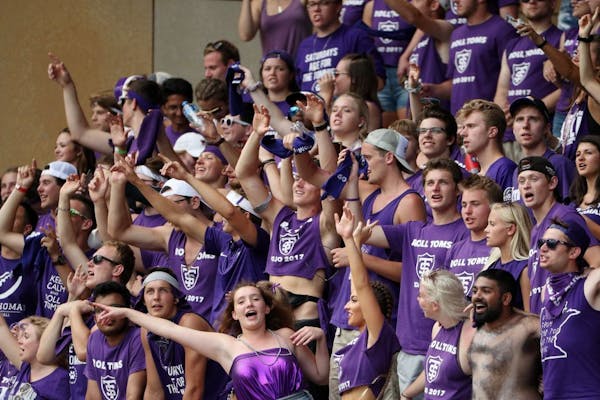The state of Minnesota was brimming with college football success last season, when the Gophers went 11-2, Minnesota State Mankato reached the Division II championship game and Division III powers St. Thomas and St. John's combined to go 20-4.
With the COVID-19 pandemic, nobody knows when the next chance to build on that momentum will be.
Forecasting when college football will return is as much of an inexact science at the Division II and III levels as it is for the Gophers and powerhouse Power Five programs like defending national champion Louisiana State.
"This is uncharted territory with no road map," MSU Mankato athletic director Kevin Buisman said.
The Division II schedule already is shrinking. The NCAA passed a rule this week that caps the number of regular-season games each D-II football team can play at 10, down from 11 for several schools. The new rules also state that teams can qualify for the postseason with as few as seven regular-season games. These cuts also are being considered at the D-III level.
"The question becomes, what is a meaningful season?" said Cory Sauter, the coach at Division II Southwest Minnesota State. "As you dip below eight, I don't know if that would be considered a season. That's hard to imagine."
Any best-case scenario for college football first requires a target date for actual returning to on-campus learning, then practice. It's about creating a safe environment. It's about figuring out how much time is needed to prepare for a season — and then how many games teams can actually play.
Before practices and games, bringing students safely back to campus is the first step toward avoiding the worst-case scenario: no fall sports, period.
That scenario would cost the University of Minnesota an estimated $75 million, for example, according to school projections. And losing football would do major damage to any college athletic department.
As long as we have an environment with students on campus and in classes, I feel very comfortable about engaging in athletics," St. Thomas athletic director Phil Esten said. "If we're at a point where we are 100 percent virtual and distance learning again, then I think it's a different conversation."
The key dates
At the Football Bowl Subdivision (FBS) level, the Gophers and other teams are scheduled to start practice between July 20 and July 27, giving them up to six weeks to prepare for their first scheduled games in late August or early September.
NCAA Division II and III schools would start practice about Aug. 12, allowing three weeks of preparations before their seasons start in early September.
Even if the University of Minnesota begins school in some form in late August as expected, college football games starting at the same time doesn't seem realistic, Regent Michael Hsu said.
"There are a lot of schools that have said they want to do in-person classes, but you don't know," Hsu said. "It's easier for smaller schools than bigger schools."
In May, the NCAA approved temporary rules changes to allow football and basketball players to participate in summer workouts without being enrolled in summer school. On Wednesday, the NCAA took another step by allowing those players to be able to do voluntary on-campus activities starting June 1.
The Gophers aren't sure what date they will have athletes return, AD Mark Coyle said. They are closely working on that plan with campus leadership and health officials.
In a normal calendar year, college football teams at all levels basically would have no offseason. Players would go from spring ball to summer workouts to fall camp. A "new normal" amid the virus crisis, though, is revamping the college sports landscape.
At Mankato, Buisman said the plan right now is for face-to-face instruction for the fall semester starting Aug. 24. That will come with a hybrid option for online classes.
Well before that, some type of coronavirus testing could be done for Mavericks athletes arriving for summer workouts, Buisman hopes. They will need housing, too. Single-player dorms are also being considered for a number of schools wanting to abide by distancing standards.
"Will there be pre-practice protocols for symptom monitoring and temperature checks?" Buisman said. "We're starting to have those discussions."
'Football shape'
Winona State coach Tom Sawyer looked out of his living room window last Friday to see his wife leading a yoga class for football players on their front lawn.
After Minnesota Gov. Tim Walz recently loosened state restrictions to allow public gatherings of up to 10 people, the Sawyer residence became a popular training spot.
At the Division II level, NCAA rules were tweaked in May to allow athletes in team sports to have voluntary workouts at the players' request until the fall semester.
"We had guys with their mats social distancing out in the yard — it was pretty cool," Sawyer said. "That's directed by the players. But it does help us recover some time we lost in the spring."
There is a deep concern, though, from coaches about their players being in "football shape" when they meet again, whenever that is. The NCAA's decision Wednesday allows football players to have voluntary workouts on campus throughout June, but will that prepare them enough physically for a shortened fall camp in July or August?
Tightening that window of preparation further would put even more pressure on players "physically, mentally and emotionally," St. Thomas coach Glenn Caruso said.
"There would have to be a true evaluation where the guys are at," Caruso added. "It will look different whether it means starting slower, changing of gear, smaller groups. Some of those I can predict and some of them I can't. So many levels have to be checkmarked before we get a chance to play a football game."
Weight rooms, training rooms and locker rooms are filled with hundreds of sweaty, dirty and busy football players every spring, summer and fall, often with little regard for hygiene.
Those days are over. It's a serious matter to keep cleaner and safer during the virus crisis.
Minnesota Duluth AD Josh Berlo said his department is reviewing all cleaning protocols to increase the frequency of sanitizing those areas. The school is planning to have masks available to all athletes and staff. Trainers are working on robust screening systems to test for symptoms of COVID-19.
"We're going to take a lot of extra precautions," Berlo said. "It's difficult to have a fully safe or sanitized environment, but we're going to embrace the best practices."
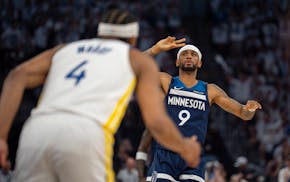
NAW makes Timberwolves' shortened bench stand tall; Warriors dig deeper for help
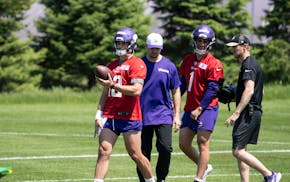
Former Gophers quarterback looks forward to 'my journey' with Vikings
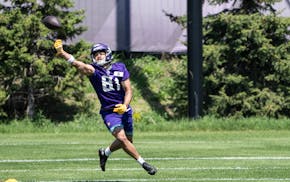
Montigo Moss, working to make the Vikings roster, provides an update on famous father Randy
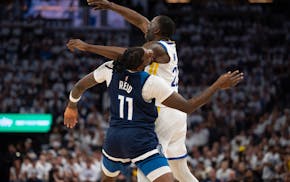
Draymond Green and Thursday's technical foul

